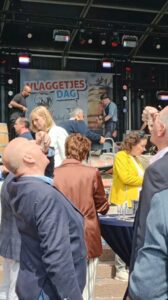Herring Tradition The Story of Hollandse Nieuwe:
“Nieuwe Hollandse Haring,” or Dutch herring, is a culinary icon in the Netherlands, known for its distinctive flavor and health benefits due to its high levels of Omega-3 fatty acids. But the history of Dutch herring is as rich as its taste, with roots that run deep in Dutch tradition and culture.
Consuming herring in the Netherlands is a beloved Dutch tradition. Many tourists find it thrilling to purchase herring for the first time, grasp the entire fish by its tail, and let it glide down their throats in the customary Dutch manner.
Nieuwe Hollandse Haring is not just a food, but an intrinsic part of Dutch culture and history. From its revolutionary preservation technique developed in the Middle Ages, to contemporary celebrations marking the beginning of the herring season, this fish has a special place in the hearts and diets of the Dutch.
Herring Tradition The Story of Hollandse Nieuwe
Historical origins
The history of herring in the Netherlands dates back to the Middle Ages. It was during the 14th century that Willem Beukelszoon, a Dutch fisherman, developed an innovative cleaning technique that transformed the way herring was handled and preserved. This technique, known as “gibbing,” involves removing the fish’s innards while leaving the pancreas intact, whose enzymes help keep the meat fresh longer. This method revolutionized the fishing industry and enabled the Dutch to become a leader in the herring trade in Europe.
Cultural significance
Over the centuries, herring has become a national symbol, celebrated annually during events such as the “Vlaggetjesdag” in Scheveningen, where the first barrel of herring of the season is traditionally auctioned off. This festival is a time of celebration and tradition, emphasizing the importance of herring in Dutch culture.
Modern production
Today, herring production follows strict regulations established by the “Nederlands Visbureau” to ensure the quality and tradition of the product. Herring must be caught between May and July, when it is at its peak fat content. After fishing, the fish is frozen for at least 24 hours to remove parasites, a process that dates back to 1968 to ensure food safety. For a long period, herring was heavily overfished and nearly faced extinction. Fortunately, the species has now recovered thanks to global quotas that limit the number of herring fishermen are permitted to catch at a time.
Hollandse Nieuwe Haring
“Hollandse Nieuwe Haring,” or “Dutch New Herring,” refers to a traditional Dutch delicacy made from young herring caught between mid-May and early July. This period is crucial because the herring must have a high fat content of at least 16%, ensuring its characteristic rich flavor and tender texture.
The preparation of Hollandse Nieuwe Haring involves a specific process:
Cleaning: The herring is first cleaned, with the gills and part of the head removed. The pancreas is left inside, which helps in the curing process.
Salting and Ripening: The fish is then lightly salted and left to ripen for a couple of days. The pancreas enzymes help to tenderize the fish and develop its flavor.
Freezing: To meet health regulations and ensure the fish is safe to eat, the herring is frozen for at least 24 hours at -20°C to kill any parasites.
After this process, the herring is thawed and ready to be consumed. Traditionally, it is eaten raw, often with chopped onions and sometimes pickles. The classic way to eat it involves holding the fish by its tail and letting it slide into your mouth.
Herring and health
In addition to its delicious flavor, Dutch herring is prized for its nutritional benefits. Rich in Omega-3, vitamin D, and protein, it is a food that supports cardiovascular health and general well-being.
Preparation and Consumption
Traditional Dutch herring is eaten raw, often accompanied by chopped onions and pickles, or placed in a sandwich known as “broodje haring.” This way of eating herring reflects the simplicity and purity of Dutch cuisine, where fresh ingredients take center stage. The Dutch take it by the tail, tilt it over their heads and eat it in bites, often accompanied by chopped onions and pickles. This method of consumption is known as “haringhappen.”

Would you like to enhance your trip to the Netherlands?
Enhance your trip to the Netherlands with our tailored services! From accessible tours and mobility equipment rentals to convenient hotel bookings, we cater to all your travel needs. Experience the beauty and culture of the Netherlands with options designed for your comfort and accessibility. Explore our offerings today and make the most of your visit!

Experience the best of the Netherlands with our thoughtfully designed accessible tours. Enjoy cultural attractions, scenic sights, and guided explorations that cater to your mobility needs, ensuring an enriching experience for everyone.

Find the perfect accommodation with our hotel booking service. We offer a selection of accessible hotels that prioritize your comfort, ensuring a restful stay as you explore the beauty of the Netherlands.

Make your journey easier with our mobility equipment rental service. From wheelchairs to scooters, we provide high-quality equipment to help you navigate the Netherlands comfortably and confidently.

